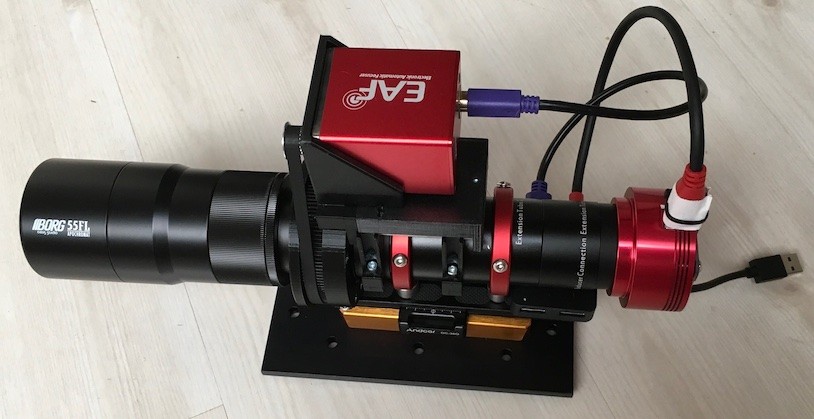Jan75 this RA spike is also mirrored by a smaller DEC spike.
This "coupling" is puzzling.
The next time you have a chance, and if it is possible, rotate the guide camera angle until one of the axis of the frame is parallel to the declination plate. I.e., turn the camera angle so that the red and blue vectors in the Calibration popup are pointing to the x and y axis, instead of rotated by some angle.
This will decouple the correction vector (i.e., the rotation matrix will have close to zero off-diagonal terms). This reduces one possible error, and at the same time make the PHD2 log easier to analyze by eye.
It is easiest to do by pointing the USB cable to the camera at one of the four cardinal points, like the example below, vertically up relative to its dovetail plate, for one of my guide scopes:

If you still see x and y graphs coupling after that, then the error is not (at least not likely) caused by the strain wave gears (i.e., no chance the gears on the RA motor and declination motor have flaws right at the same time). I.e., kind of good news.
So the places to look for are:
. wind
. slippage (dovetail clamps not locked down) or guide tube band not tight, mount not tight with tripod,
. loose spacer rings
. tripod not on stable ground
... stuff like that
All that being said, don't get too concerned about short term glitches on the guide graph. If it last for just one second out of a 180 second exposure, you will never see any ill effect on the final frame. Too many people take guide graphs as gospel, without thinking about what it means practically.
Rumen (one of INDIGO's principals) and I were just discussing it not many weeks ago, and we both think that Root Mean Square is a very poor estimate of guide errors because it over-emphasizes short large pulses (RMS takes the square root of the average of squares, and square of a large number is really, really large), while even if you move a star 1 arc minute away for a short time, it will do no harm since there is not enough integration time for enough photoelectrons to register on the plate.
The magnitude of error is not a problem - how long it stays away from perfect guiding is the problem.
My recommendation to you is that you can ignore the short (time) deviations, even if the magnitude (arc seconds) is large.
Chen